Neighborhood Graphs built with Morphological Operators
DOI:
https://doi.org/10.13037/ria.vol4n2.309Keywords:
Morphological Operators, Mathematical MorphologyAbstract
A method for building neighborhood graphs using morphological operators is presented in this paper. This method has a segmented image as input, containing objects that will define the graph vertices. The edges of the graph will be determined by the neighborhood between these objects, defined by the watershed. We will carry out morphological operations in each partition of the watershed to define the edges of the graph. These graphs can be used efficiently to solve various problems in image processing and is also a powerful structure used in mathematical morphology.Downloads
References
[1] G. J. F. BANON and J. BARRERA. Decomposition of mappings between complete lattices by mathematical morphology, Part I: general lattices. Signal Processing, 30,:299-327, 1993.
[2] J. BARRERA, F. A. ZAMPIROLLI, and R.A. LOTUFO. Morphological operators characterized by neighborhood graphs. In L. H. de FIGUEIREDO and M. L. NETTO, editors, SIBGRAPI'97 - X Brazilian Symposium on Computer Graphic and Image Processing, pages 179-186. IEEE Computer Society, October 1997.
[3] J. BONDY and U. MURTY. Graph theory with applications. The Macmillan Press LTD, London, 1976.
[4] B. CHAZELLE and H. EDELSBRUNNER. An improved algorithm for constructing kth - order Voronoi diagrams. ACM, 16:228-234, 1985.
[5] T. CORMEN, C. LEISERSON, and R. RIVEST. Introduction to Algorithms. The MIT Press, Cambridge, Mass., 1990.
[6] J. CRESPO. Morphological connected filters and intra-region smoothing for image segmentation. Novembre 1993.
[7] L. FIGUEIREDO and P. CARVALHO. Introdução à Geometria Computacional. Instituto de Matemática Pura e Aplicada, Rio de Janeiro-RJ, 1991.
[8] L. GUIBAS and J. STOLFI. Primitives for the manipulation of general subdivisions and the computation of Voronoi diagrams. ACM Transactions on Graphics, 4 - N.2, April:74-123, 1985.
[9] R. JONES. A graph-based segmentation of eucalypt pulpwood images. CSIRO Division of Mathematics and Statistics - North Ryde - Australia, 1996.
[10] M. JÜNGER, G. REINEL, and D. ZEPF. Computing correct Delaunay triangulations. Computing, 47:43-49, 1991.
[11] D.-T. LEE. On k-nearest neighbor Voronoi diagrams in the plane. IEEE - Transactions on Computers, C-31:478-487, 1982.
[12] F. P. PREPARATA and M. I. SHAMOS. Computational Geometry: an Introduction. Springer Verlag, 1985.
[13] P. REZENDE and J. STOLFI. Fundamentos de Geometria Computacional. IX Escola de Computação, Recife-PE, 1994.
[14] P. SALEMBIER and J. SERRA. Flat Zones Filetring, Connected Operators, and Filters by Reconstruction. IEEE Transactions on Image Processing, 4(8):1153-1160, August 1995.
[15] J. SERRA. Image Analysis and Mathematical Morphology. Academic Press, London, 1982.
[16] J. SERRA, editor. Image Analysis and Mathematical Morphology - Volume II : Theoretical Advances. Academic Press, London, 1988.
[17] F. Y. SHIH and O. R. MITCHELL. A mathematical morphology approach to Euclidean distance transformation. IEEE Transactions on Image Processing, 1:197-204, 1992.
[18] L. VINCENT. Graphs and mathematical morphology. Signal Processing, 16:365-388, April 1989.
[19] F.A. ZAMPIROLLI. Operadores morfológicos baseados em grafos de vizinhanças - uma extensão da mmach toolbox. Master's thesis, Departamento de Ciência da Computação, Instituto de Matemática e Estatística, Unversidade de São Paulo, CP 66.281, CEP 05315-970, São Paulo, SP, Brazil, April 1997.
Downloads
Published
Issue
Section
License
Copyright (c) 2010 Francisco de Assis Zampirolli

This work is licensed under a Creative Commons Attribution-NonCommercial-ShareAlike 4.0 International License.
Os autores que publicam trabalhos na RIA estão de acordo com os seguintes termos:
- Autores mantêm seus direitos autorais e concedem à RIA o direito à primeira publicação. Admite-se o compartilhamento do referido trabalho, desde que seja reconhecida sua autoria e publicação inicial nesta revista.
- Autores podem fechar contratos adicionais separadamente, para distribuição não exclusiva da versão do trabalho publicado na RIA, com reconhecimento de sua autoria e publicação inicial nesta revista.
- Autores podem publicar e distribuir seu trabalho online, antes ou durante o processo editorial.


